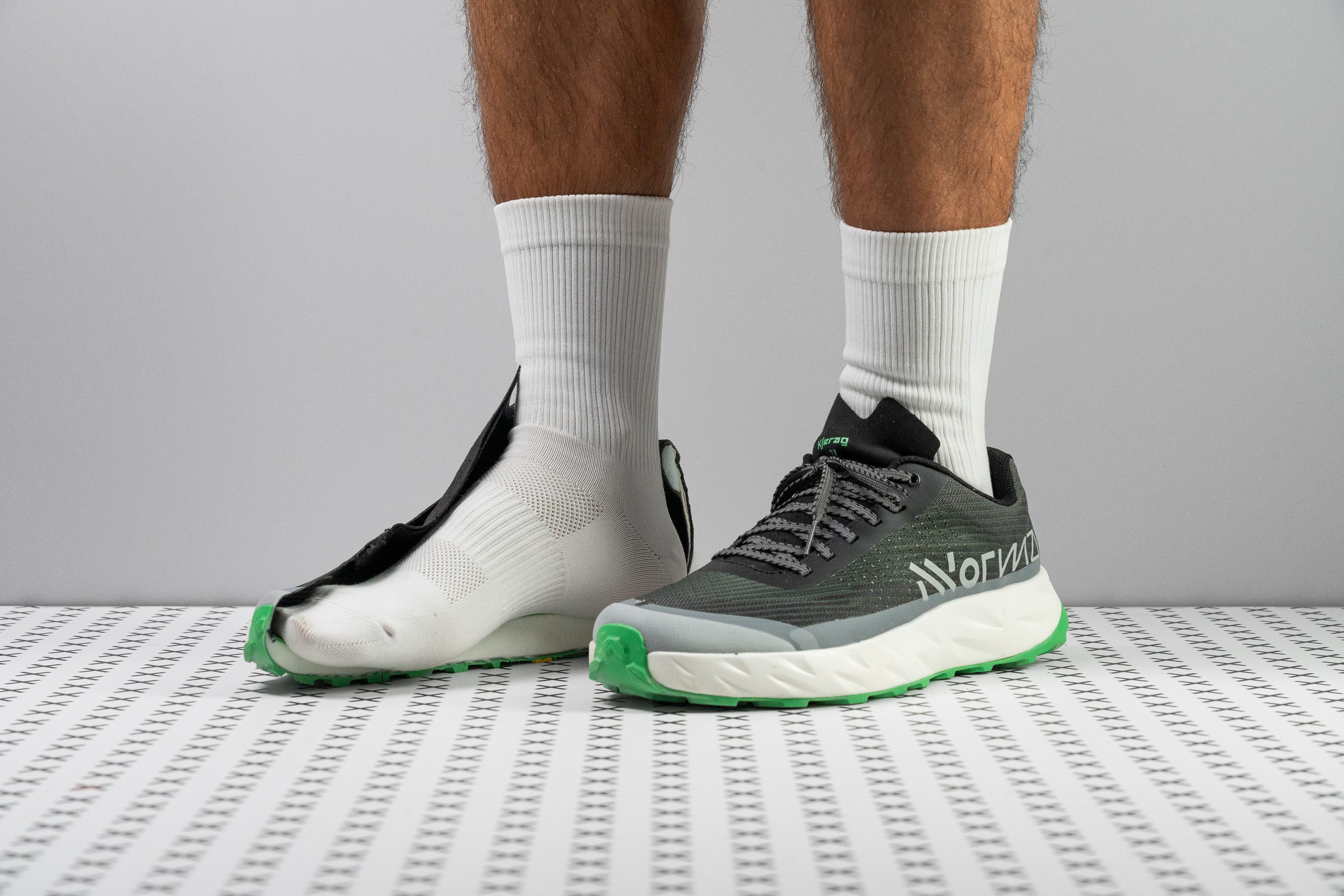Our verdict
- Top pick in best running shoes for hiking
Pros
- Premium materials
- Vibram Megagrip outsole
- Low carbon footprint
- Race-ready fit
- Lightweight
- Stable, grounded ride with tons of feedback
- Ideal for short races and skyrunning events
- Handles corners with ease
- Doubles as a hiking shoe
Cons
- Not the best for heel strikers
- High price tag
- Limited breathability
- No reflective elements
Audience verdict
- Top 1% in trail running shoes
- Top 2% in neutral running shoes
Comparison
The most similar running shoes compared
+ + Add a shoe | |||||
|---|---|---|---|---|---|
| Audience score | 93 Superb! | 89 Great! | 84 Good! | 86 Good! | |
| Price | $195 | $170 | $180 | $150 | |
| Trail terrain | Light | LightModerate | Moderate | LightModerate | |
| Shock absorption | Moderate | - | - | Moderate | |
| Energy return | Moderate | - | - | Moderate | |
| Arch support | Neutral | Neutral | Neutral | Neutral | |
| Weight lab Weight brand | 7.5 oz / 214g 7.1 oz / 200g | 9 oz / 255g 9.4 oz / 266g | 7.5 oz / 213g 8 oz / 227g | 10.1 oz / 286g 9.2 oz / 260g | |
| Lightweight | ✓ | ✗ | ✓ | ✗ | |
| Drop lab Drop brand | 8.6 mm 6.0 mm | 6.8 mm 6.0 mm | 7.2 mm 5.0 mm | 7.2 mm 6.0 mm | |
| Strike pattern | Mid/forefoot | Mid/forefoot | Mid/forefoot | Mid/forefoot | |
| Size | True to size | True to size | Slightly small | True to size | |
| Midsole softness | Balanced | Balanced | Soft | Soft | |
| Difference in midsole softness in cold | Normal | Normal | Big | Big | |
| Plate | ✗ | Rock plate | ✗ | ✗ | |
| Toebox durability | Decent | Very bad | Very bad | Bad | |
| Heel padding durability | Decent | Good | Good | - | |
| Outsole durability | Decent | Decent | Decent | - | |
| Breathability | Warm | Warm | Moderate | Moderate | |
| Width / fit | Medium | Narrow | Narrow | Narrow | |
| Toebox width | Medium | Wide | Medium | Narrow | |
| Stiffness | Flexible | Stiff | Stiff | Moderate | |
| Torsional rigidity | Moderate | Moderate | Moderate | Flexible | |
| Heel counter stiffness | Flexible | Flexible | Flexible | Moderate | |
| Lug depth | 3.0 mm | 2.9 mm | 3.7 mm | 2.8 mm | |
| Heel stack lab Heel stack brand | 25.0 mm 23.5 mm | 28.3 mm 30.0 mm | 29.8 mm 30.0 mm | 30.6 mm 32.0 mm | |
| Forefoot lab Forefoot brand | 16.4 mm 17.5 mm | 21.5 mm 24.0 mm | 22.6 mm 25.0 mm | 23.4 mm 26.0 mm | |
| Widths available | Normal | Normal | Normal | Normal | |
| Season | All seasons | All seasons | All seasons | All seasons | |
| Removable insole | ✗ | ✓ | ✓ | ✗ | |
| Orthotic friendly | ✗ | ✓ | ✓ | ✗ | |
| Ranking | #4 Top 2% | #81 Top 22% | #228 Bottom 38% | #178 Top 48% | |
| Popularity | #267 Bottom 28% | #240 Bottom 35% | #306 Bottom 17% | #210 Bottom 43% |
Who should buy
We believe the NNormal Kjerag is an amazing choice for trail runners looking for something different from mainstream brands. After rigorous testing, we’re confident it’s crafted for:
- Runners wanting a nimble, close-to-ground, fast-paced shoe for races and speed sessions.
- Eco-focused athletes with a larger budget, prioritizing premium, sustainable materials.
- Trail runners favoring agility and responsiveness over high-stack cushioning. And it works great for hiking too!
- Anyone that loves the Spanish trail-running legend Kilian Jornet and wants to support his latest project!
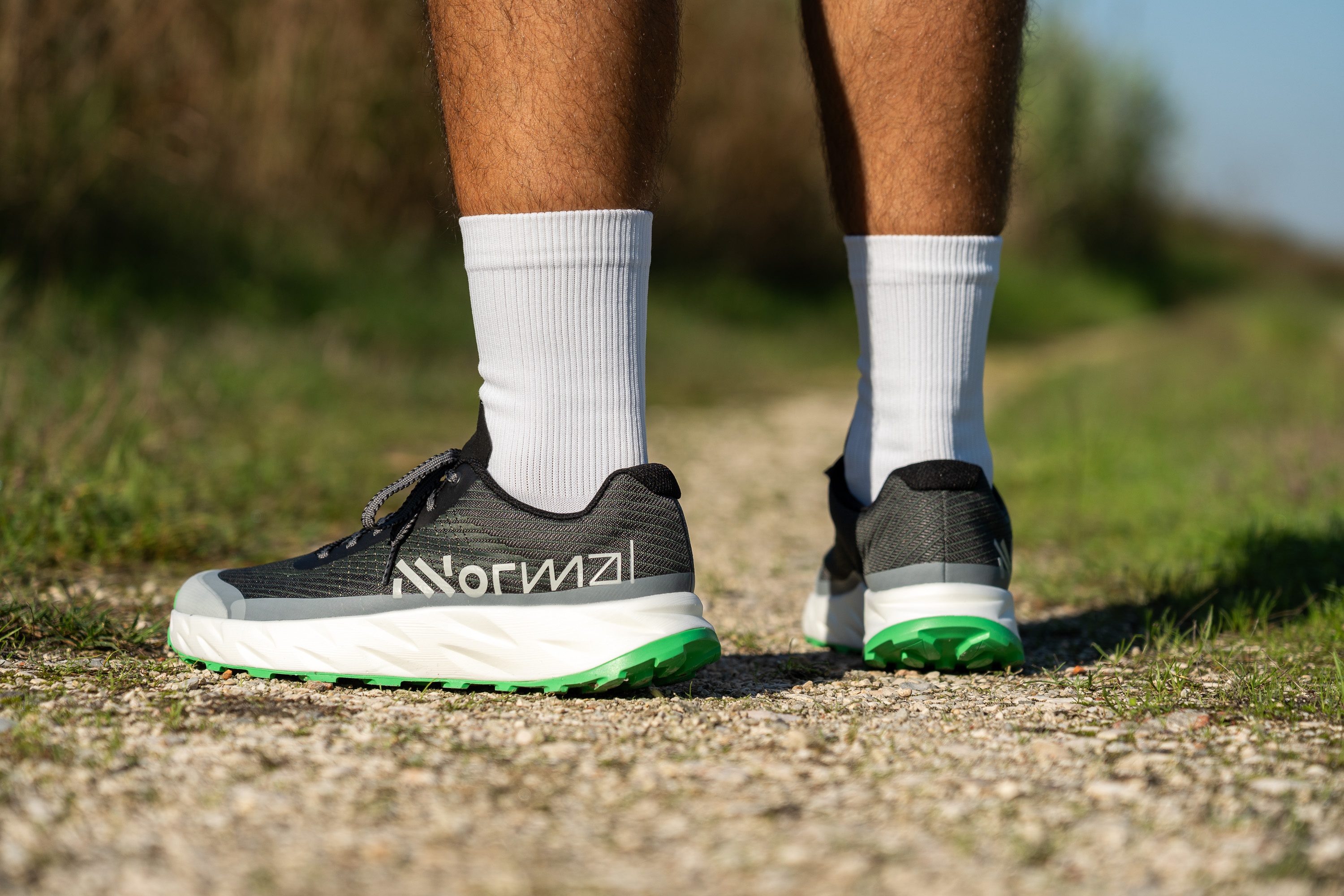
Who should NOT buy
The Kjerag is built for speed and performance, but we think it may not appeal to runners who feel that a fast shoe needs a world-class foam or a carbon plate. If that sounds like you, we recommend looking at options like the Nike Ultrafly or the Saucony Endorphin Edge, both designed to deliver a propulsive, high-energy feel in races or speed workouts.
Additionally, we believe the Kjerag demands advanced trail skills and works best with a midfoot or forefoot strike. For heel strikers or less experienced trail runners looking for extra cushioning, the Brooks Cascadia 18 or La Sportiva Prodigio could be a more reasonable purchase.
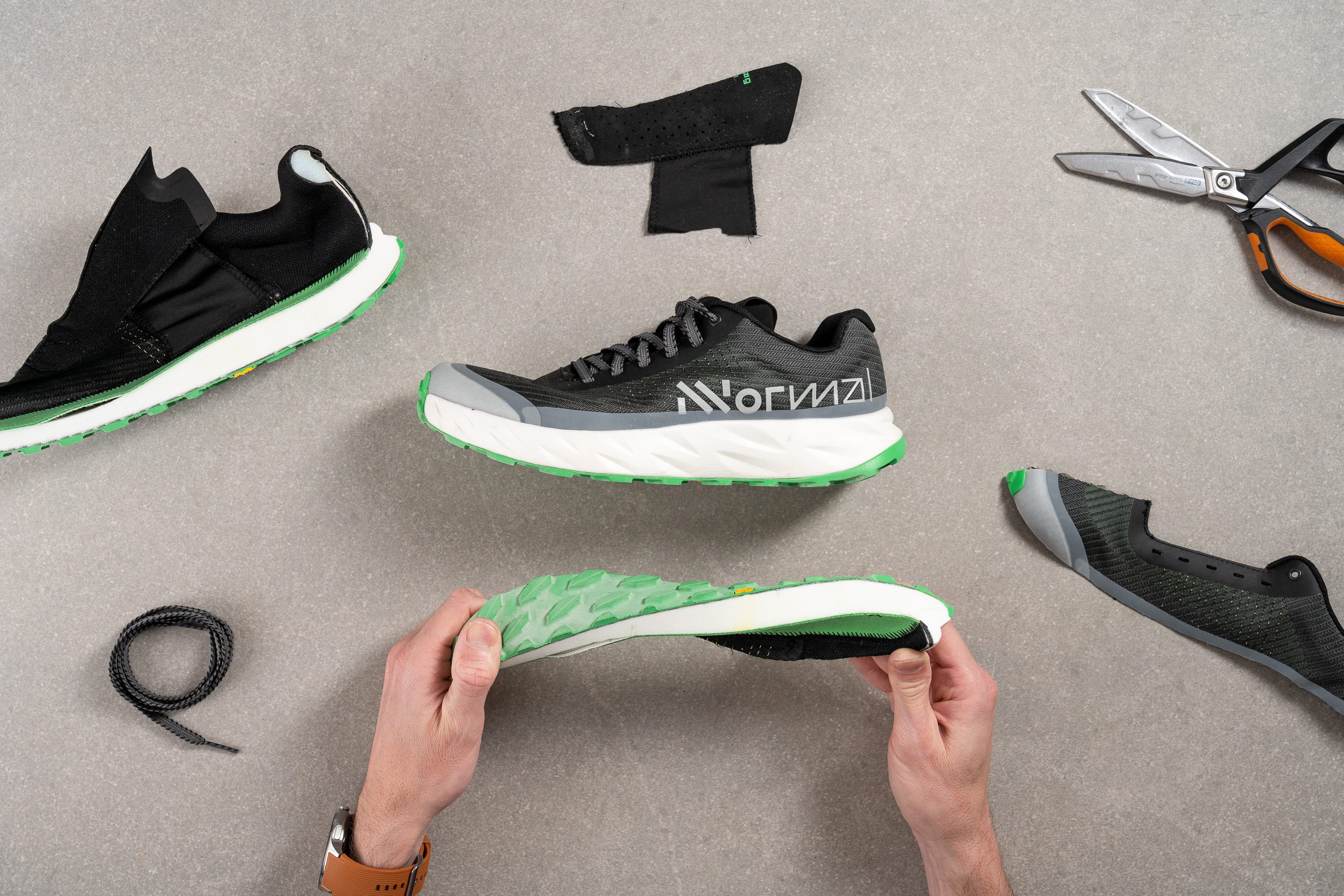
Cushioning
Shock absorption
When we tested the Kjerag using the ASTM F1976 standard, we confirmed it’s a top pick for forefoot strikers who crave ground feel and trail connection—just 62 SA in the forefoot! Conversely, the heel delivers more average shock absorption at 115 SA.

| Kjerag | 115 SA |
| Average | 122 SA |
Energy return
Energy return doesn’t stand out, but it’s good enough for most runs. We measured 56.5% in the heel and 62.6% in the forefoot.
| Kjerag | 56.5% |
| Average | 55.6% |
Heel stack
While the market leans toward higher stack heights and plush cushioning, NNormal took a different approach with this shoe.
With only 25.0 mm between the heel and the ground, it’s ideally suited for short-to-medium races and training sessions. Therefore, for those seeking a shoe meant for long distances, a shoe like the Saucony Xodus Ultra 3 is a much better choice.
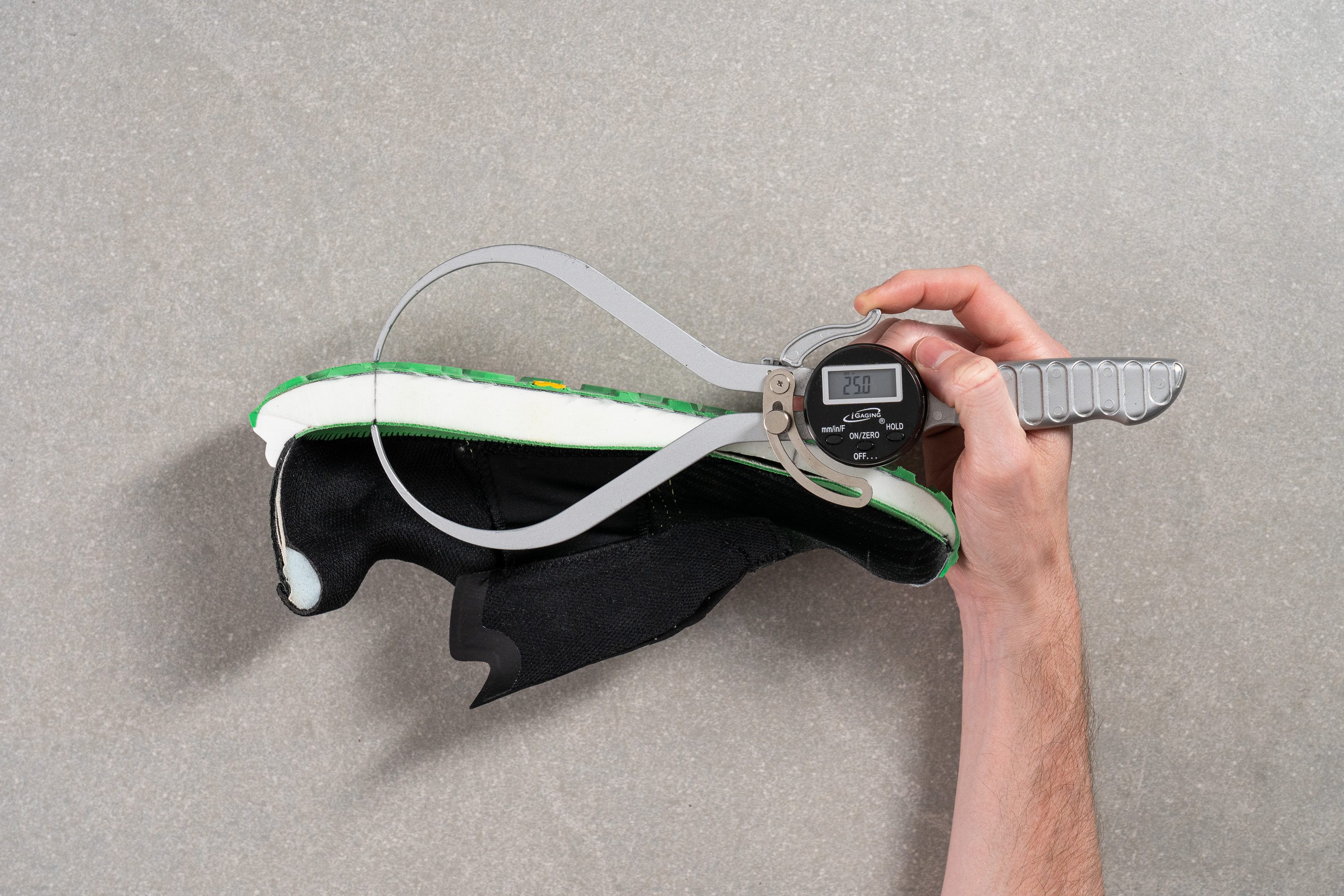
| Kjerag | 25.0 mm |
| Average | 32.6 mm |
Forefoot stack
The forefoot cushioning is remarkably thin at 16.4 mm—reminiscent of minimalist trail shoes focused on ground contact and a natural-feeling stride. In our experience, this low-profile design is ideal for runners with strong feet and good proprioception.
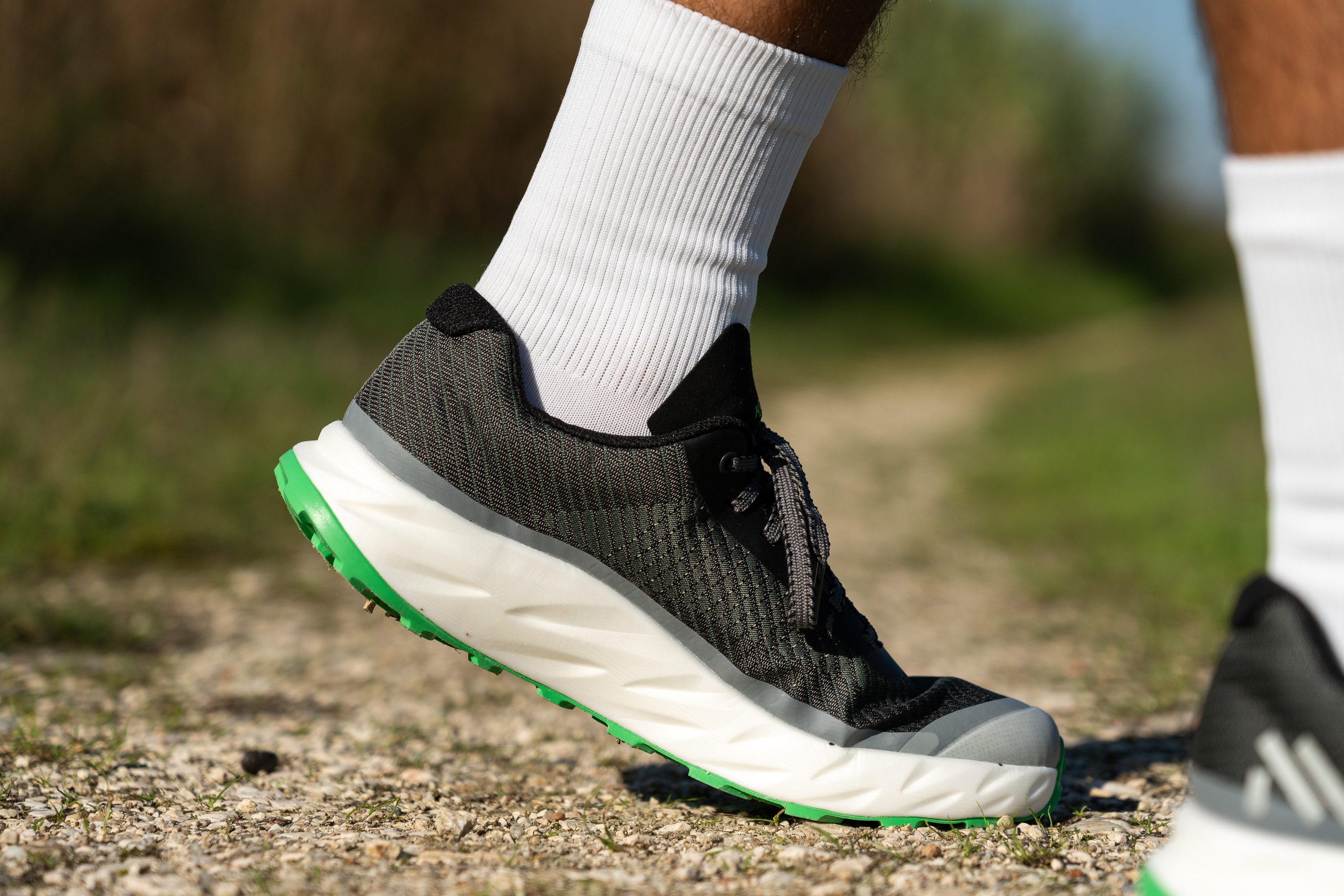
However, this lean cushioning may pose challenges for heavier runners or those with less foot strength, potentially leading to discomfort or even foot pain on longer or rougher terrain. And yes, we know Kilian Jornet can conquer a 100-miler like the UTMB in this shoe and set a course record—but let’s face it, he's not human!
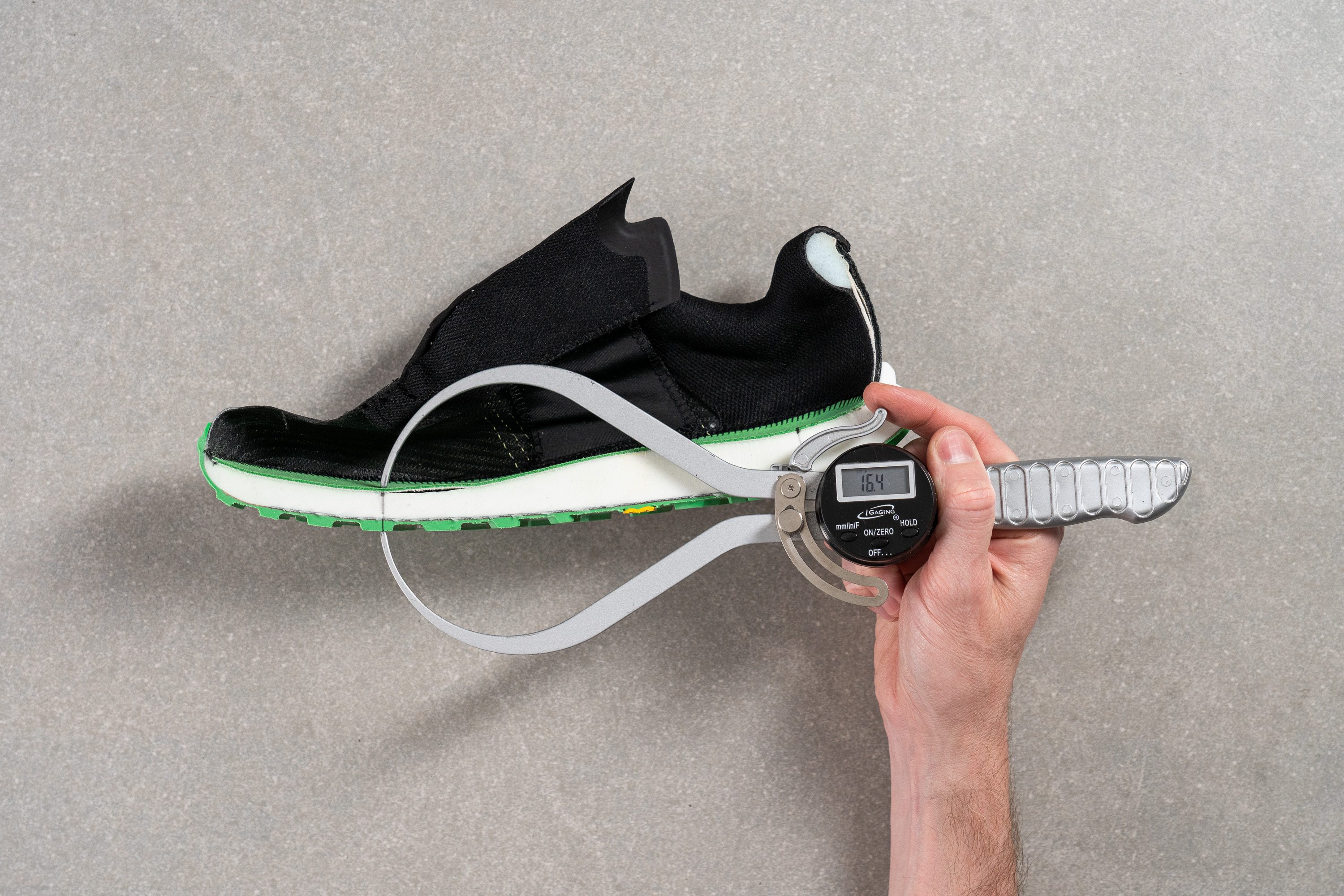
| Kjerag | 16.4 mm |
| Average | 25.1 mm |
Drop
This shoe claims a 6 mm offset, but we measured a real 8.6 mm drop at the official World Athletics points. From our photo, it's evident that the midsole leans more toward a high drop than a medium one with such a thin forefoot.
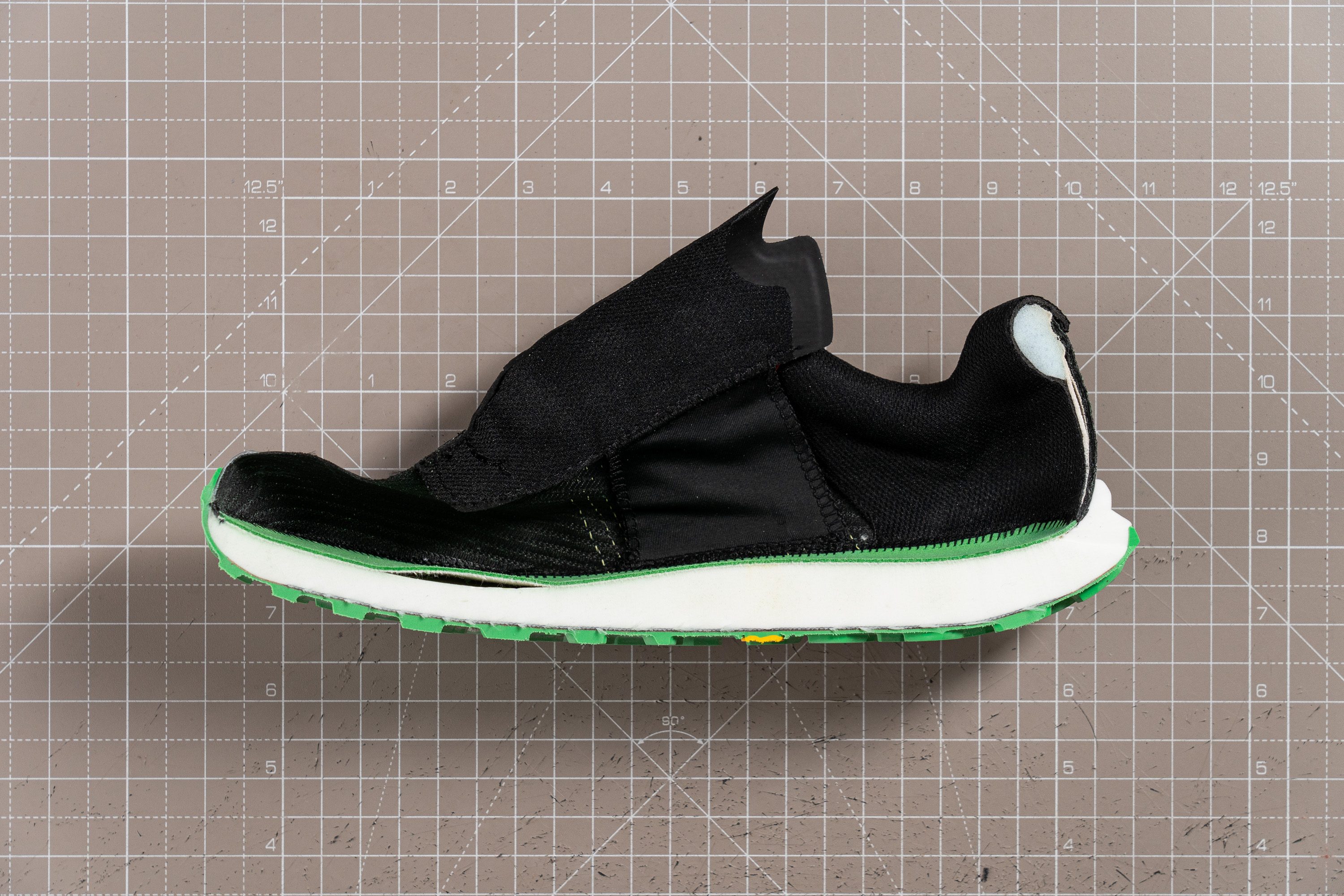
| Kjerag | 8.6 mm |
| Average | 7.5 mm |
Midsole softness
Another intriguing feature of the NNormal Kjerag—named after a renowned Norwegian trail near Kilian Jornet’s home—is its EExpure midsole.
We discovered that this supercritical EVA midsole aligns perfectly with the shoe’s lightweight design goals. As we discussed in our guide on running shoe foams, nitrogen-infused midsoles replace a portion of the foam with nitrogen, significantly reducing weight.
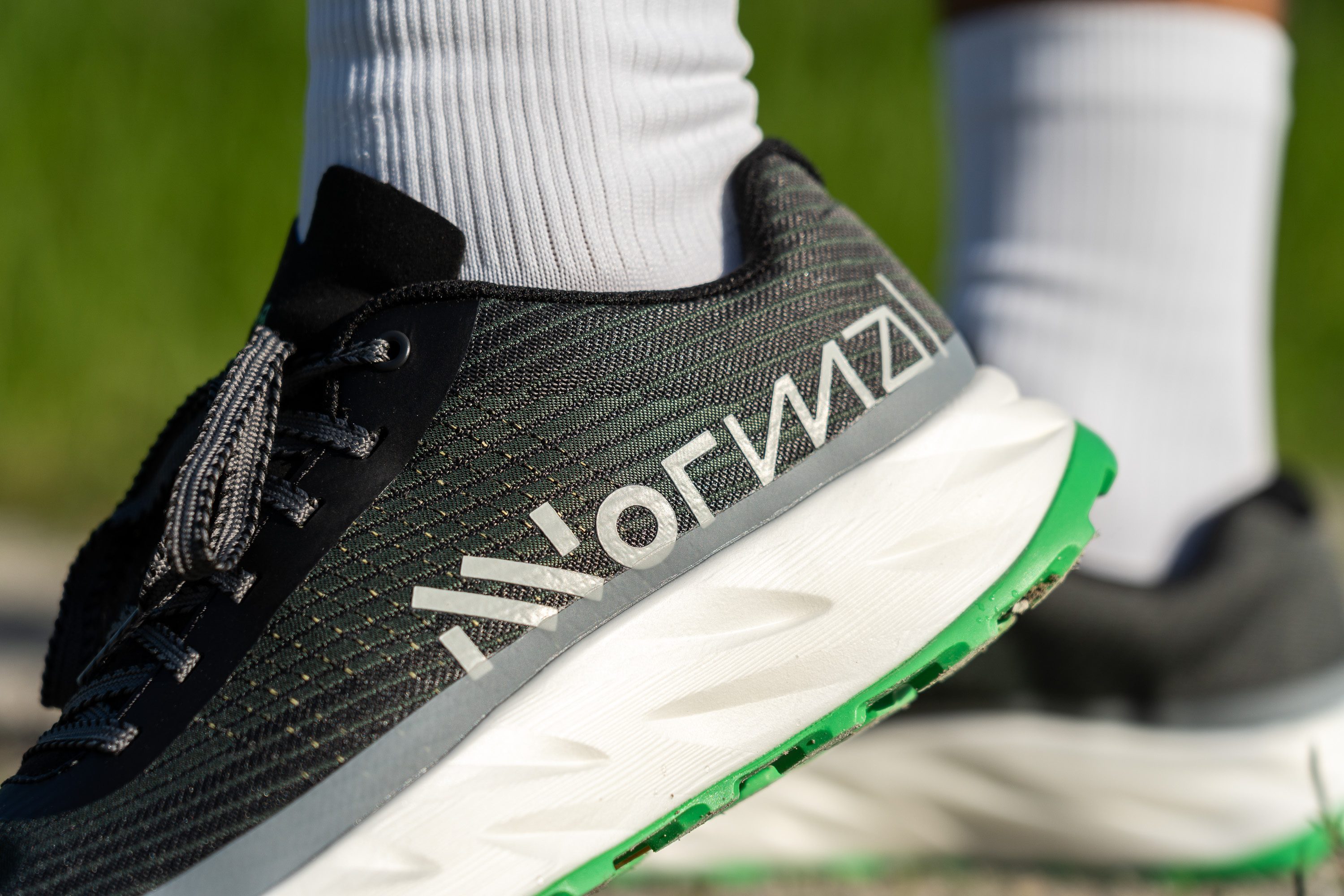
Softness is balanced at 20.6 HA, though it may feel slightly firm in the forefoot due to minimal material, as we noted earlier.
Overall, for NNormal’s first attempt at a running shoe, we believe it’s an impressive start, but we also think that for the next Kjerag a PEBA-based foam should be mandatory given the shoe's high price.

| Kjerag | 20.6 HA |
| Average | 21.9 HA |
Rocker
The Kjerag features a classic, non-rockered design that feels best suited for those with strong foot muscles and a powerful toe-off.
In the heel area we discovered a heel bevel aimed to support heel strikers with smoother transitions, although we still think that this shoe is better suited for forefoot and midfoot strikers only due to its dimensions.

Size and fit
Size
NNormal Kjerag fits true to size (56 votes).
Width / Fit
Expecting a snug fit in a race shoe is natural—competition models rarely offer the same roomy feel as their daily running counterparts. But having created a gel mold of the Kjerag, we found that it offers a sweet spot in between.
Showing 94.4 mm across the widest part, the shoe doesn't deviate far from the average medium-width running shoe.

| Kjerag | 94.4 mm |
| Average | 95.6 mm |
Toebox width
Moving our caliper closer to the toes, we got another moderate width of 72.2 mm near the big toe. This is, again, a couple of milimeters narrower than average but enough to put this NNormal shoe into the narrow bunch.
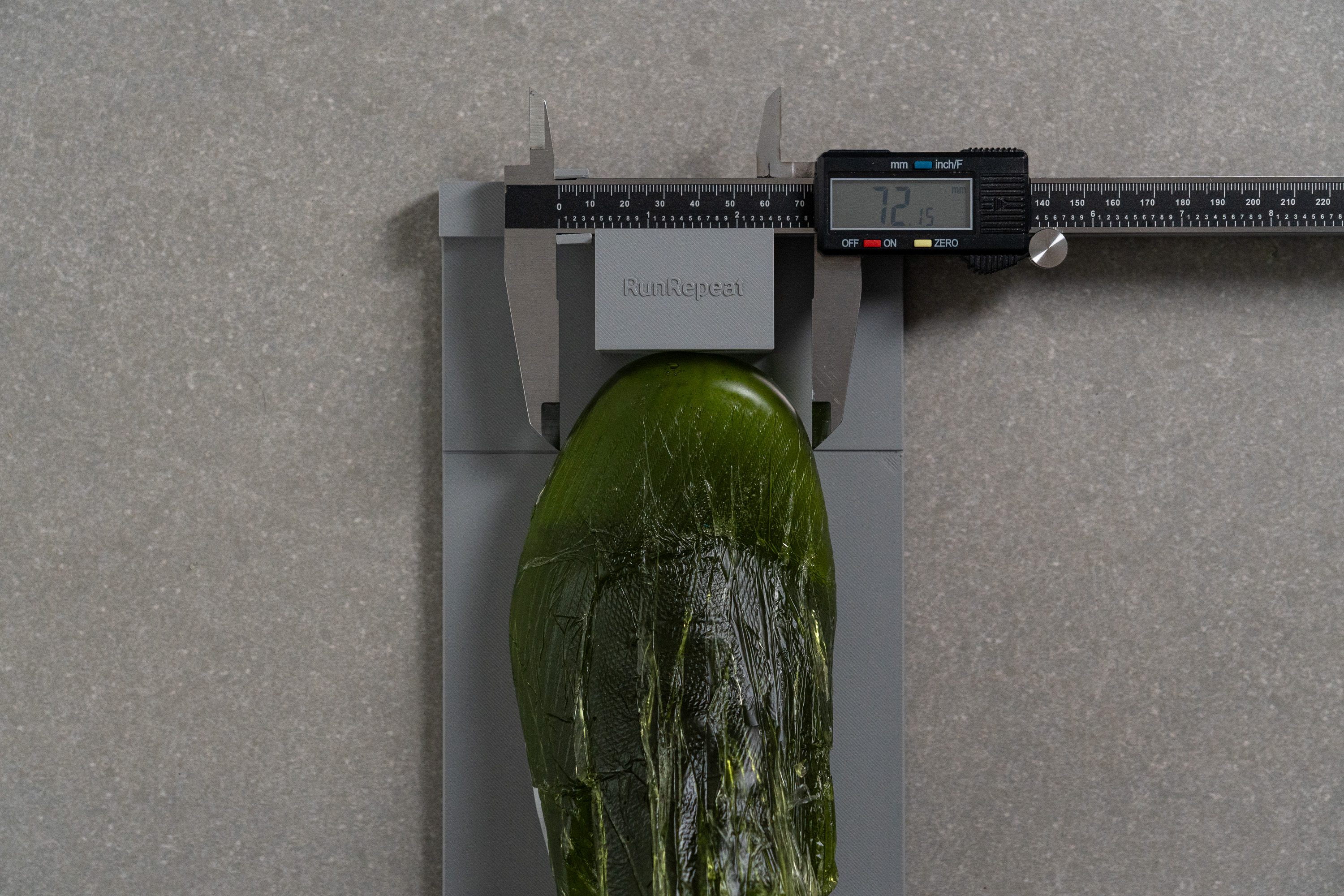
| Kjerag | 72.2 mm |
| Average | 74.6 mm |
Toebox height
We also found the shoe's vertical space quite generous for a race-ready trail shoe.
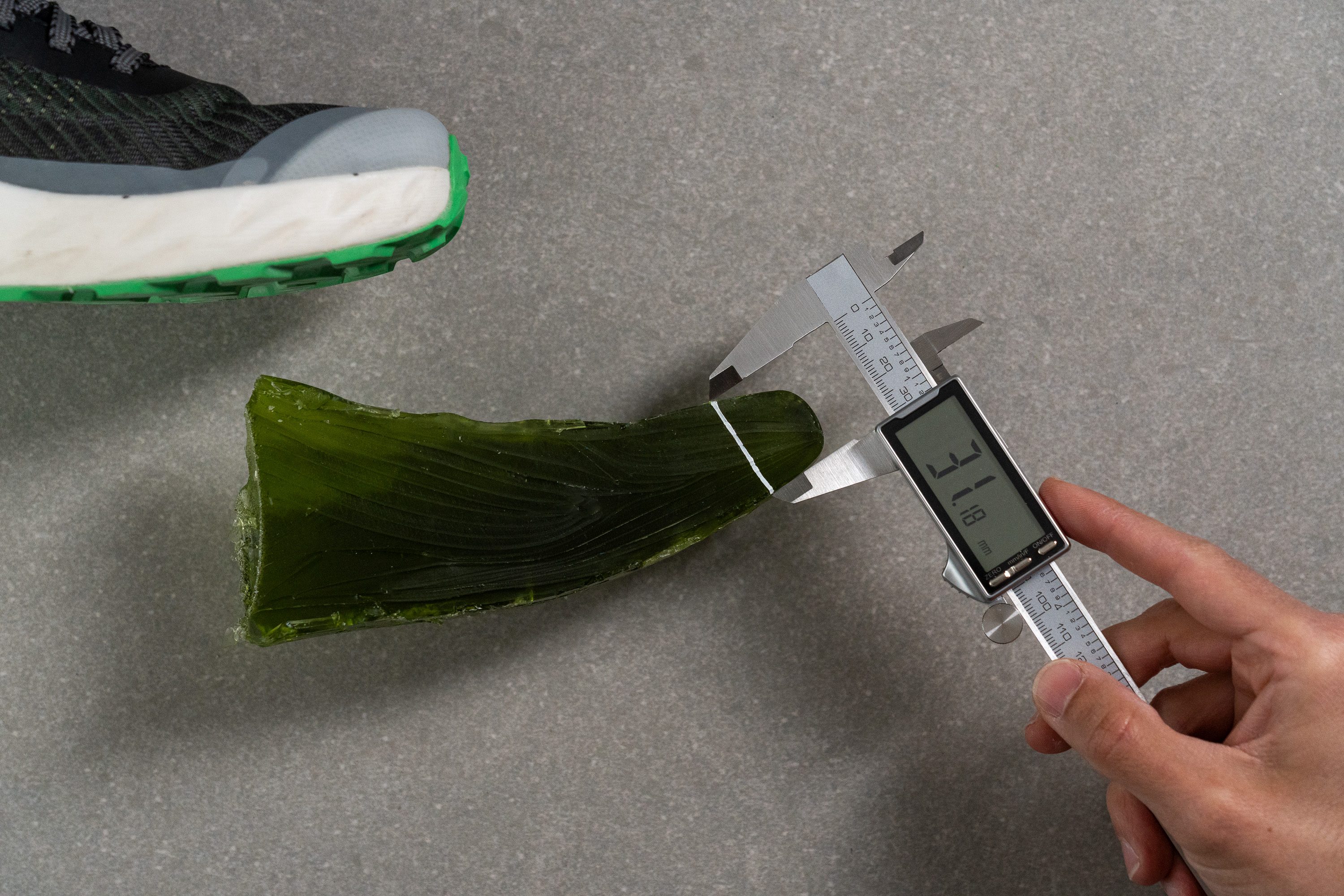
Even with a protective overlay on top of it, the shoe's toebox height returned an impressive caliper reading of 31.2 mm.
| Kjerag | 31.2 mm |
| Average | 27.1 mm |
Traction / Grip
Lug depth
Returning to the Vibram Megagrip Litebase outsole, our only disappointment is that for such a high price, we expected Traction Lugs technology—like what’s found in the Hoka Speedgoat 6.
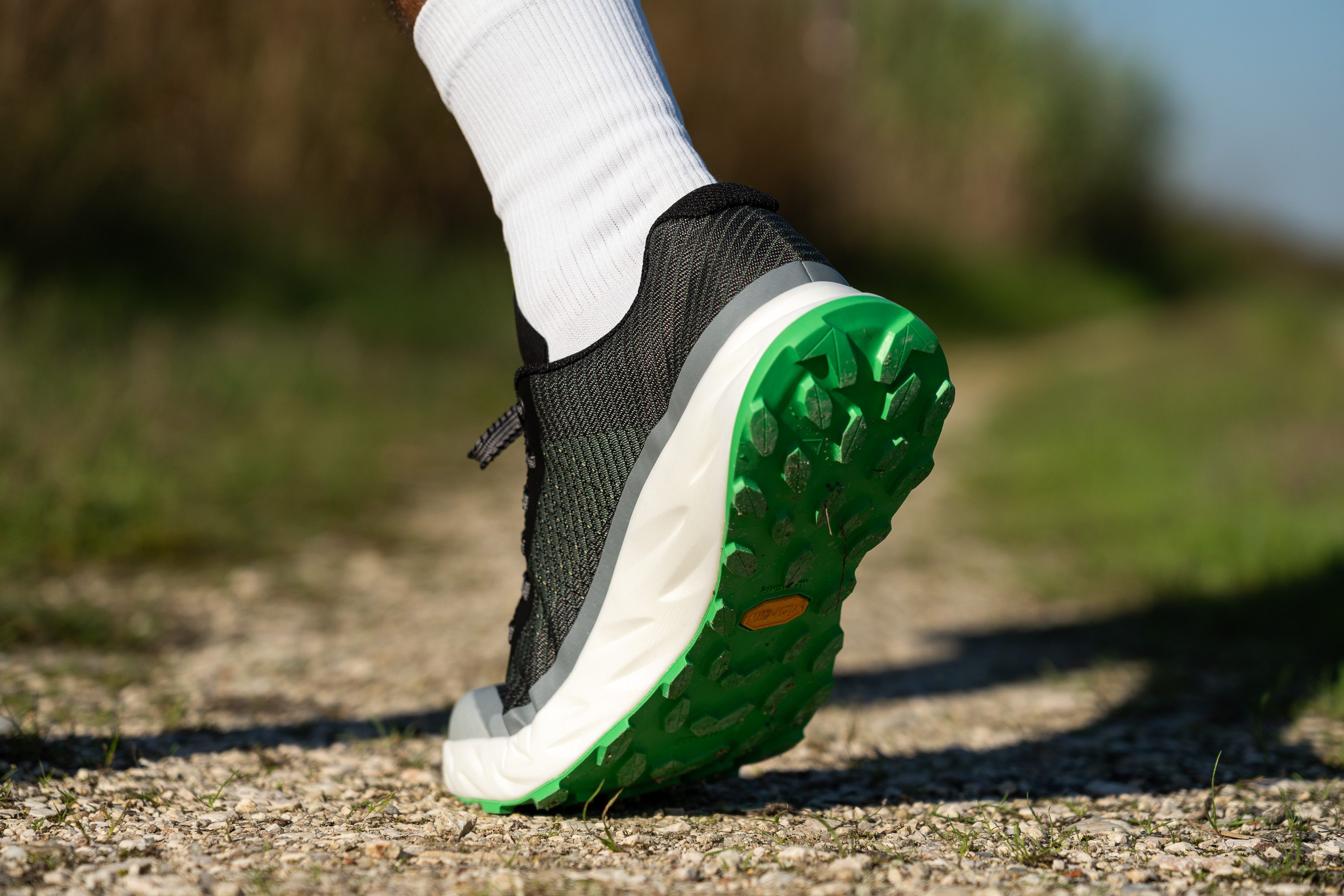
Instead, the 3.0 mm lugs are smooth on the sides, which felt a bit underwhelming. That's the price to pay for using the standard Megagrip Litebase outsole that allows for easy replacement in your local cobbler.
Still, we think the lugs are well-suited for racing, where dry conditions are common. However, if you’re running in consistently wet areas, the shallow, non-textured lugs may not provide the grip you need.

| Kjerag | 3.0 mm |
| Average | 3.5 mm |
Outsole design
NNormal chose Vibram Megagrip Litebase—widely considered the gold standard for combining durability, grip, and lightness.
Interestingly, NNormal took a different approach here. Rather than requesting a custom outsole from Vibram, they opted for the same Megagrip Litebase available to everyone. This design choice means you can easily bring the shoe to a specialized repair shop for a quick outsole replacement—an option NNormal even encourages!

Flexibility / Stiffness
We performed our standard 30-degree bend test to gauge the longitudinal flexibility of the Kjerag.
Our results showed that it required only 6.3N—way less force than we typically find. Again, this indicates its impressive flexibility, crafted for an agile ride that encourages natural movement. It also makes it a pleasure for hiking.

| Kjerag | 6.3N |
| Average | 14.7N |
Weight
Speaking of weight, this is undoubtedly one of the Kjerag’s standout strengths. At just 7.5 oz or 214g, it’s remarkably lightweight compared to most running shoes, especially within the trail category.
We believe it’s an excellent choice for runners who excel in agile, nimble, and speed-oriented shoes. However, the Kjerag does require solid running form, precise downhill technique, and a lighter build for optimal performance, as it doesn't offer a wide landing base or maximalist cushioning.
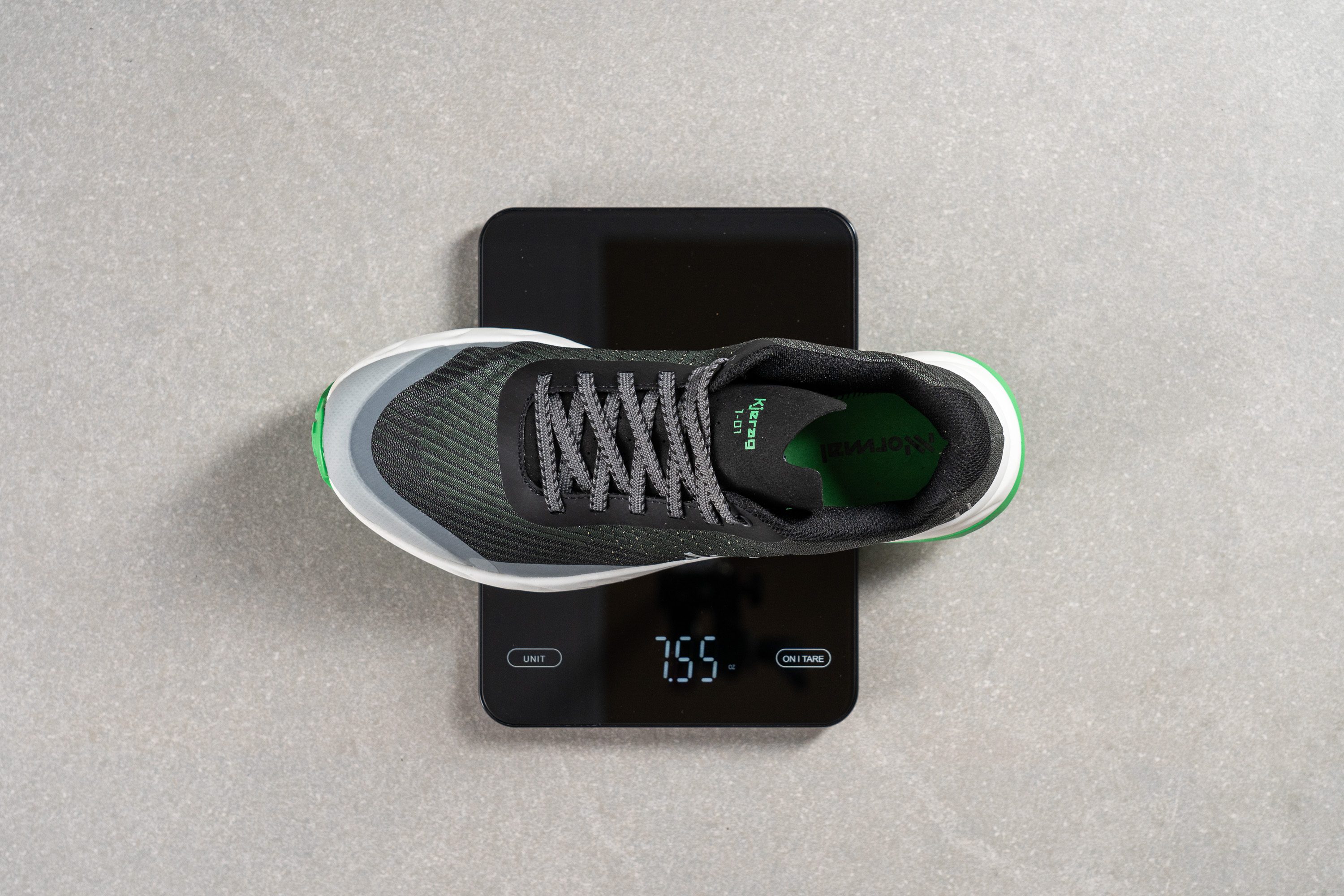
| Kjerag | 7.5 oz (214g) |
| Average | 10.2 oz (289g) |
Breathability
The NNormal Kjerag’s premium MATRYX Jacquard upper is advertised for breathability, yet in our experience, it didn’t quite live up to the claim. Compared to other trail shoes, it fell short, earning only a 2/5 in our smoke test—a bit underwhelming for a high-performance model. Here’s how we came to that conclusion.
When we moved the cut-in-half fabric over our LED flashlight, we saw very little light passing through, indicating limited ventilation too. This setup is similar to what we observe in Gore-Tex shoes, where airflow is always limited despite marketing claims.
Our microscope confirmed the tightly polyamide yarns are likely responsible for trapping air, with NNormal clearly prioritizing durability over breathability by avoiding traditional ventilation holes.
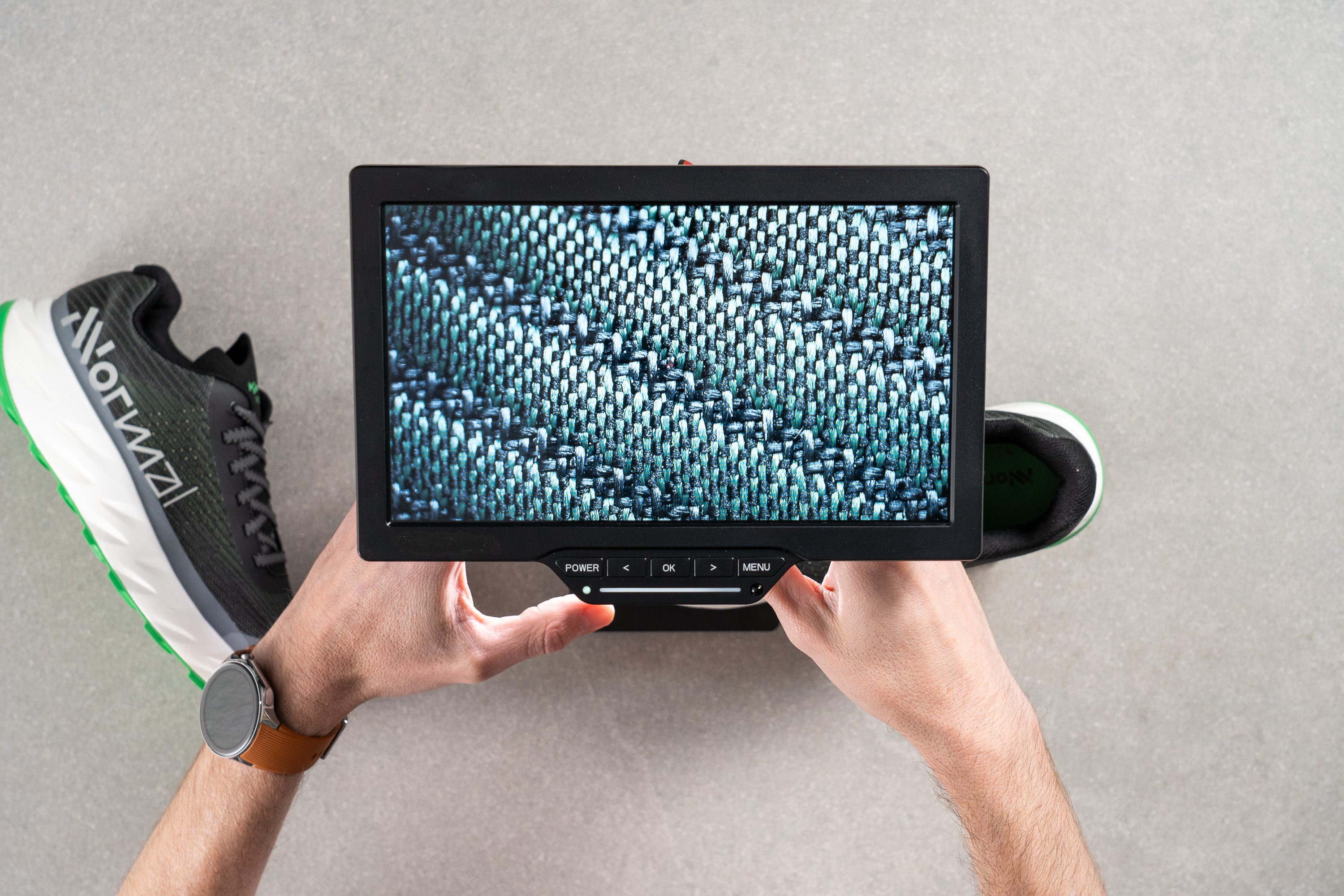
In our view, it's clear that this design choice favors ruggedness but limits cooling, which could impact comfort on warmer days.

The upper’s construction also lacks stretch and features minimal padding. However, this wasn’t unexpected, given the shoe’s racing purpose.
It’s also worth noting that the patented MATRYX upper isn’t manufactured by NNormal but by Chamatex in France, with final assembly in Asia—one of the reasons driving the shoe’s price north.
| Kjerag | 2 |
| Average | 3.2 |
Stability
Lateral stability test
While most modern running shoes boost stability through added stiffness and broader dimensions, NNormal chose a different path—staying closer to the ground.
It’s an equally effective approach, though it does come at the cost of reduced cushioning. In running shoes, every design choice comes with a trade-off.
Torsional rigidity
We encountered moderate resistance when bending and twisting the Kjerag, earning it a 3/5 rating that feels similar to a road daily trainer. This level of flexibility can only be achieved because this shoe lacks a plate.
| Kjerag | 3 |
| Average | 3.6 |
Heel counter stiffness
The heel counter on the NNormal Kjerag took us by surprise—NNormal went bold here, implementing a super-flexible, competition-grade design rated 1 out of 5.
This feather-light, pliable structure is similar to elite supershoes and, in our experience, highlights that the Kjerag feels incredible but only for those with solid trail-running skills.
| Kjerag | 1 |
| Average | 3 |
Midsole width - forefoot
In the forefoot, we measured 109.9 mm, which is notably narrower than most trail shoes. This moderate width, in our view, makes it an agile choice for sharp turns and quick direction changes, especially when running downhill.
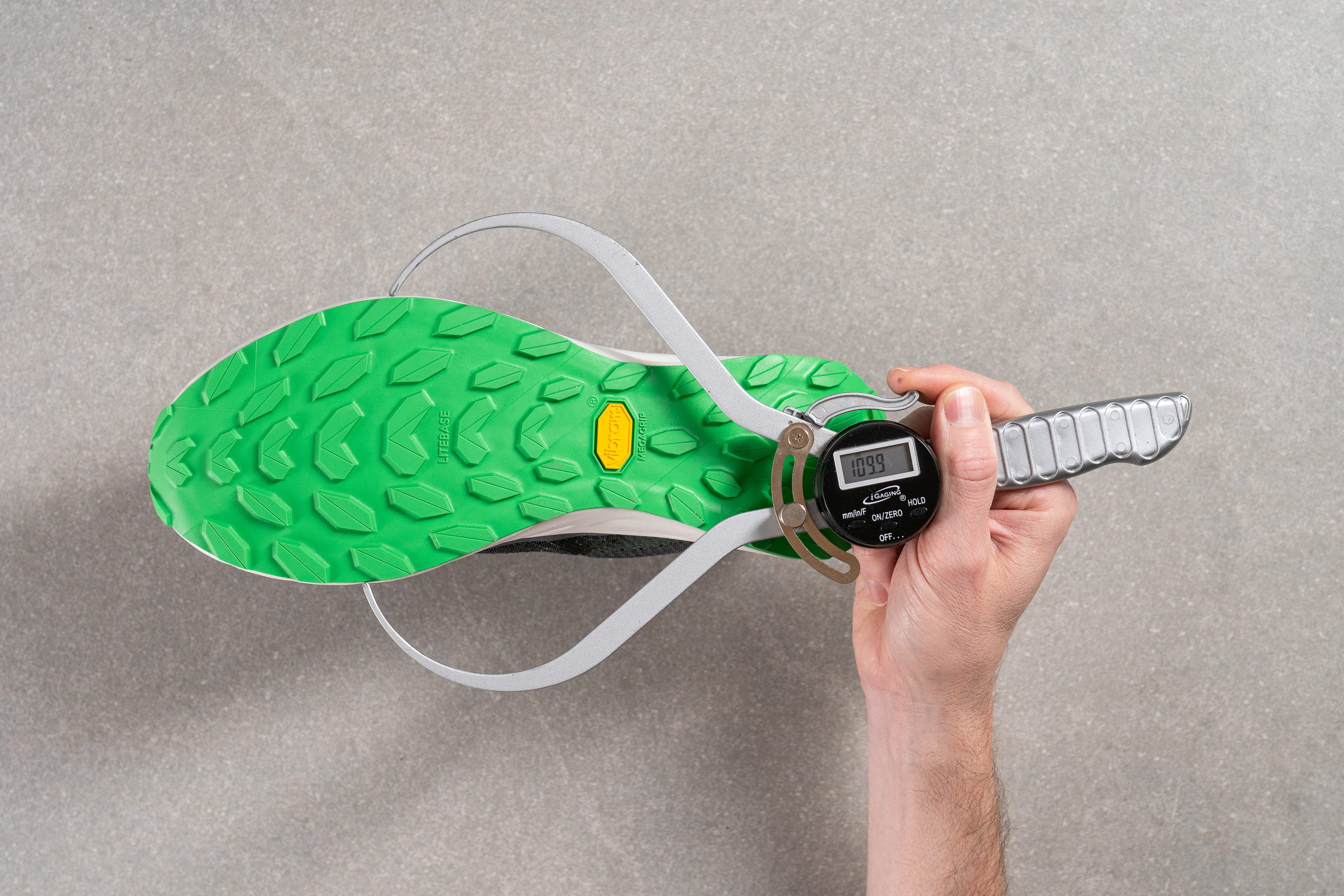
| Kjerag | 109.9 mm |
| Average | 112.8 mm |
Midsole width - heel
It’s in the heel where the Kjerag’s agile design truly shines, though we think this isn’t ideal for heel strikers. At a narrow 80.9 mm, it’s one of the slimmest trail shoes we’ve tested in the lab!
But we love this approach. The market is flooded with ultra-wide, bulky models, making the Kjerag feel like a refreshing alternative for those who crave a nimble, fun ride. Imagine the contrast between maneuvering a Dakar motorbike and a heavy Toyota Land Cruiser—that’s the kind of agility you get with the Kjerag.
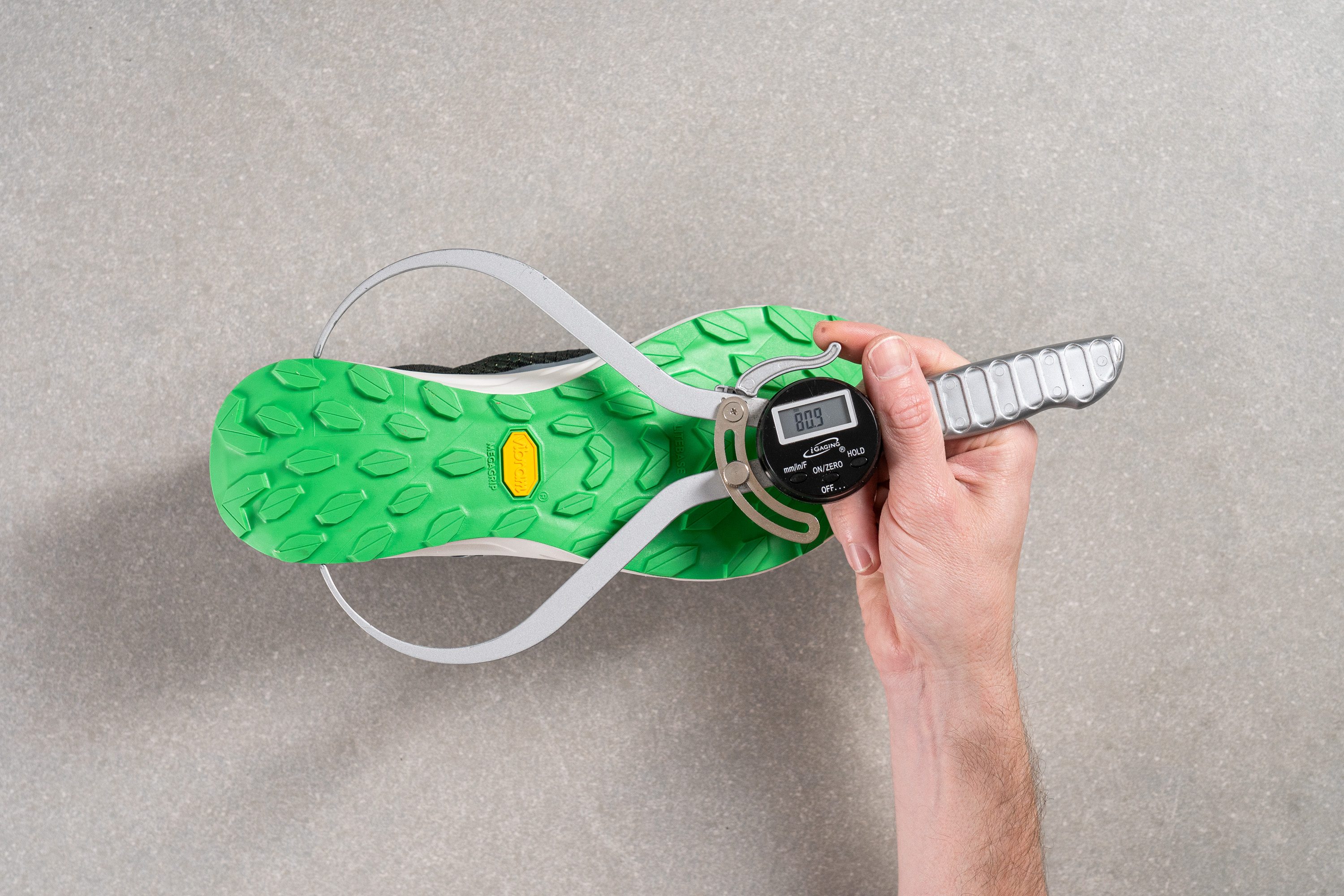
| Kjerag | 80.9 mm |
| Average | 89.9 mm |
Durability
Toebox durability
We mentioned earlier that durability might be the main reason ventilation was compromised, so we put this to the test.
After evaluating the Kjerag’s upper, we awarded it a 3/5 for durability—not an outstanding result. While the MATRYX upper with Kevlar yarns performed impressively, the thermoplastic toe bumper protection felt somewhat underwhelming.
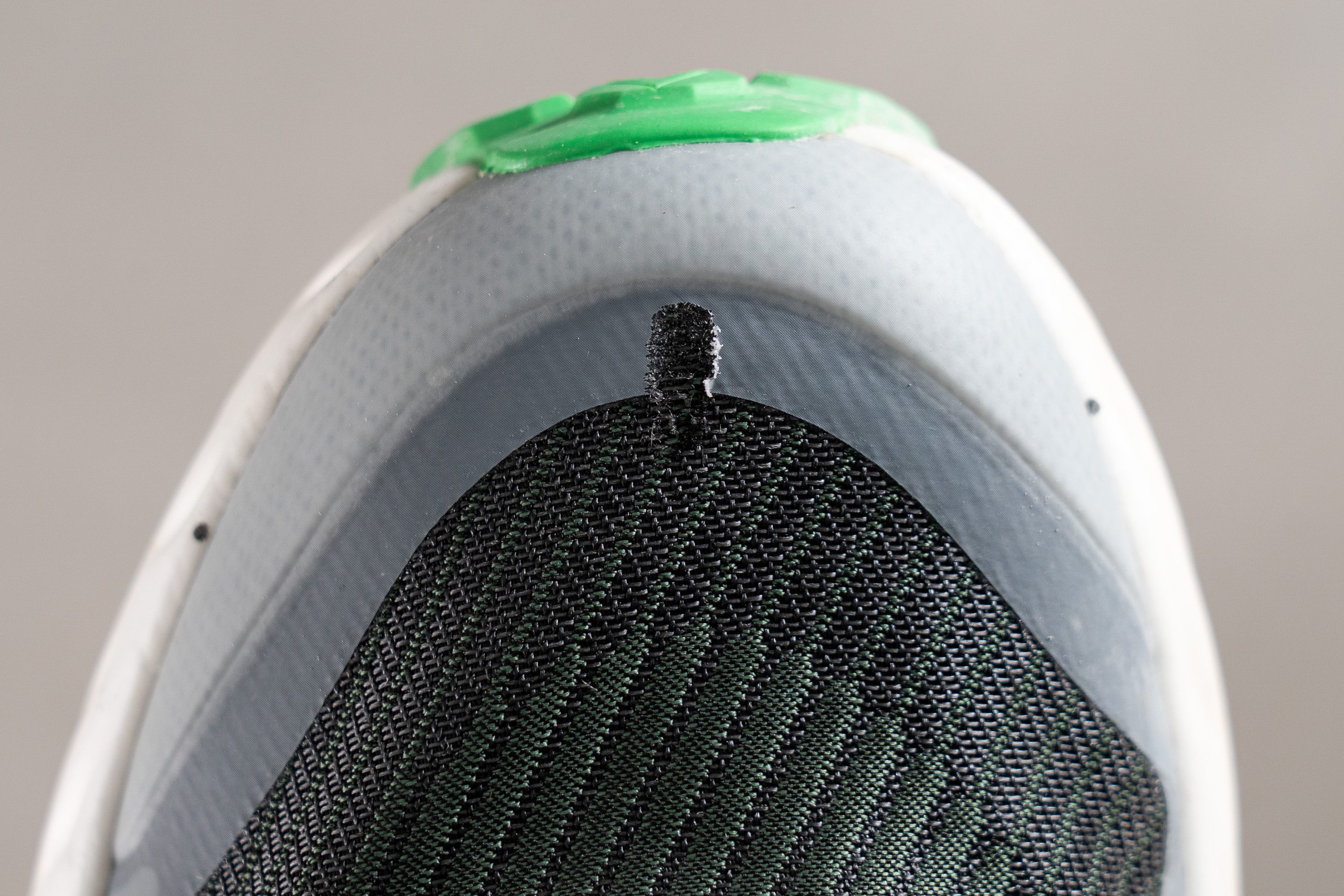
| Kjerag | 3 |
| Average | 3.1 |
Heel padding durability
When examining the heel padding, we were initially skeptical. The shoe has substantial padding here—a comfort-oriented feature that often compromises durability.
And indeed, that’s precisely what we found. After testing, a hole appeared in the padded area, suggesting that durability may be an issue, especially for those prone to wearing through this section in other running shoes. For us, this is a 2 out of 5.
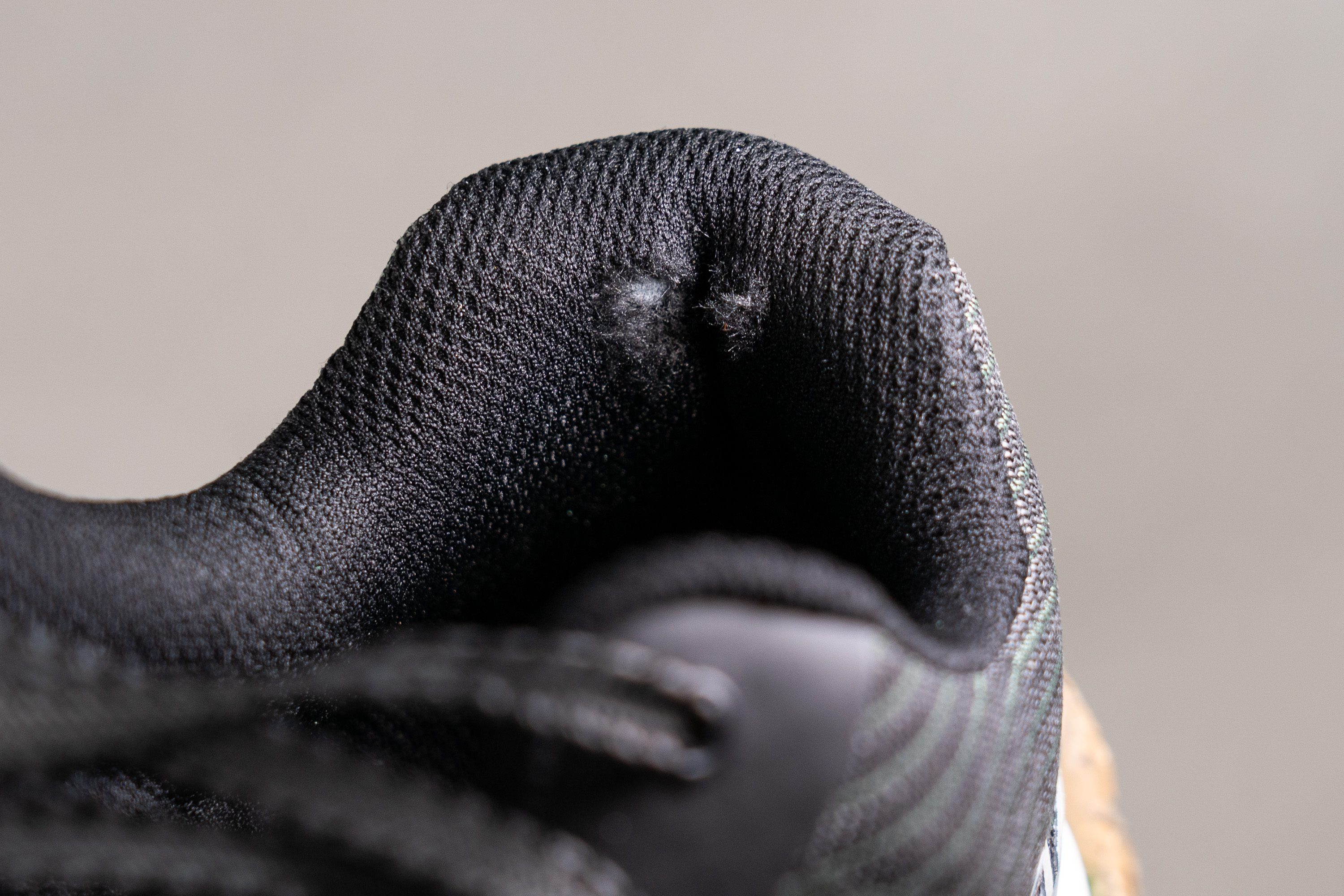
| Kjerag | 2 |
| Average | 3 |
Outsole hardness
In terms of hardness, we measured a high 88.0 HC, which aligns with the thin profile of the outsole. Nonetheless, grip performance remained outstanding in our tests.
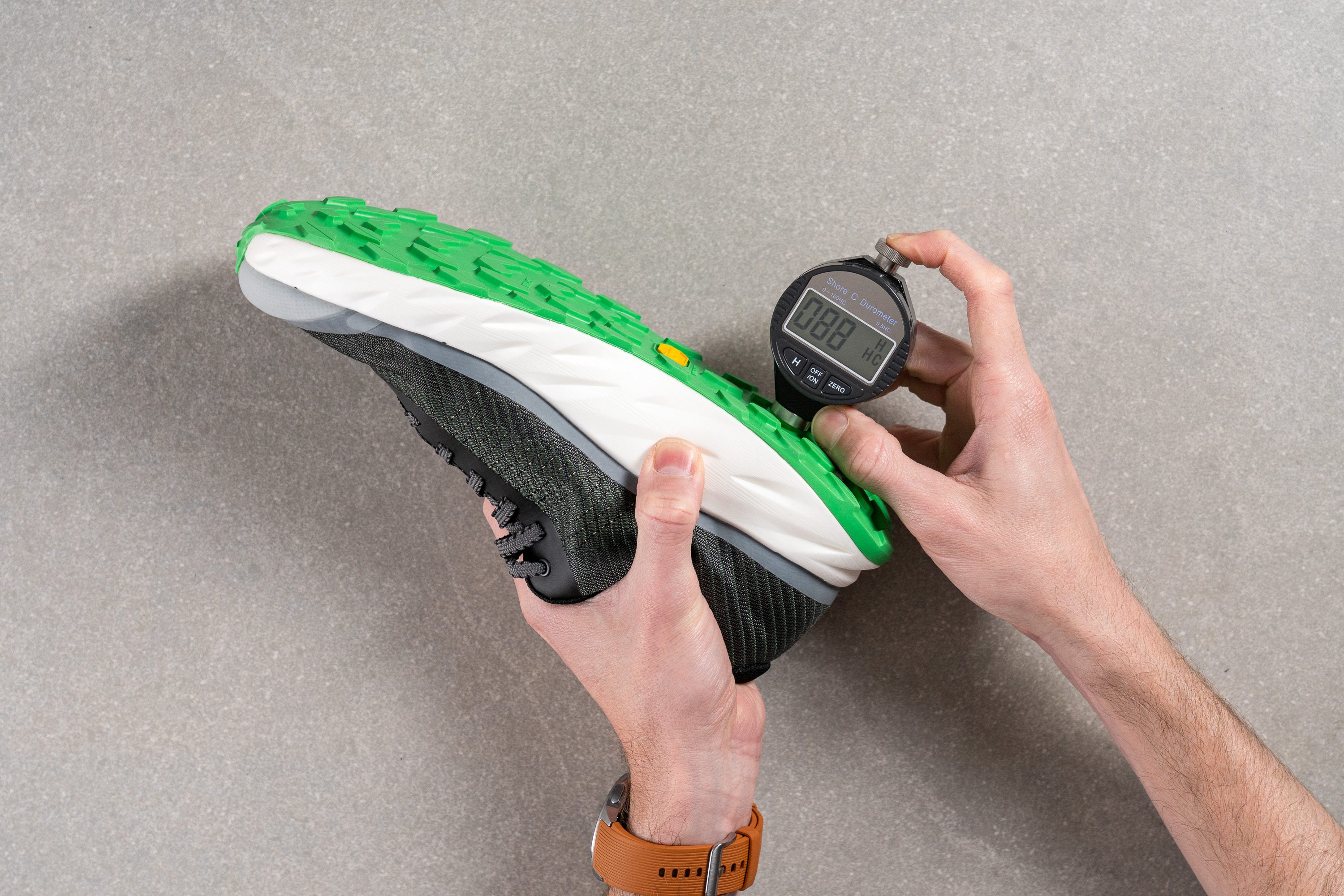
| Kjerag | 88.0 HC |
| Average | 85.8 HC |
Outsole durability
After giving the Dremel a final go in the lab, we discovered it removed 1.0 mm from the Megagrip Litebase outsole.
This result confirms solid durability across various terrains, ensuring it can withstand regular rugged use. And as we noted earlier, this outsole can be replaced by any cobbler working with Vibram, making it both durable and repairable!
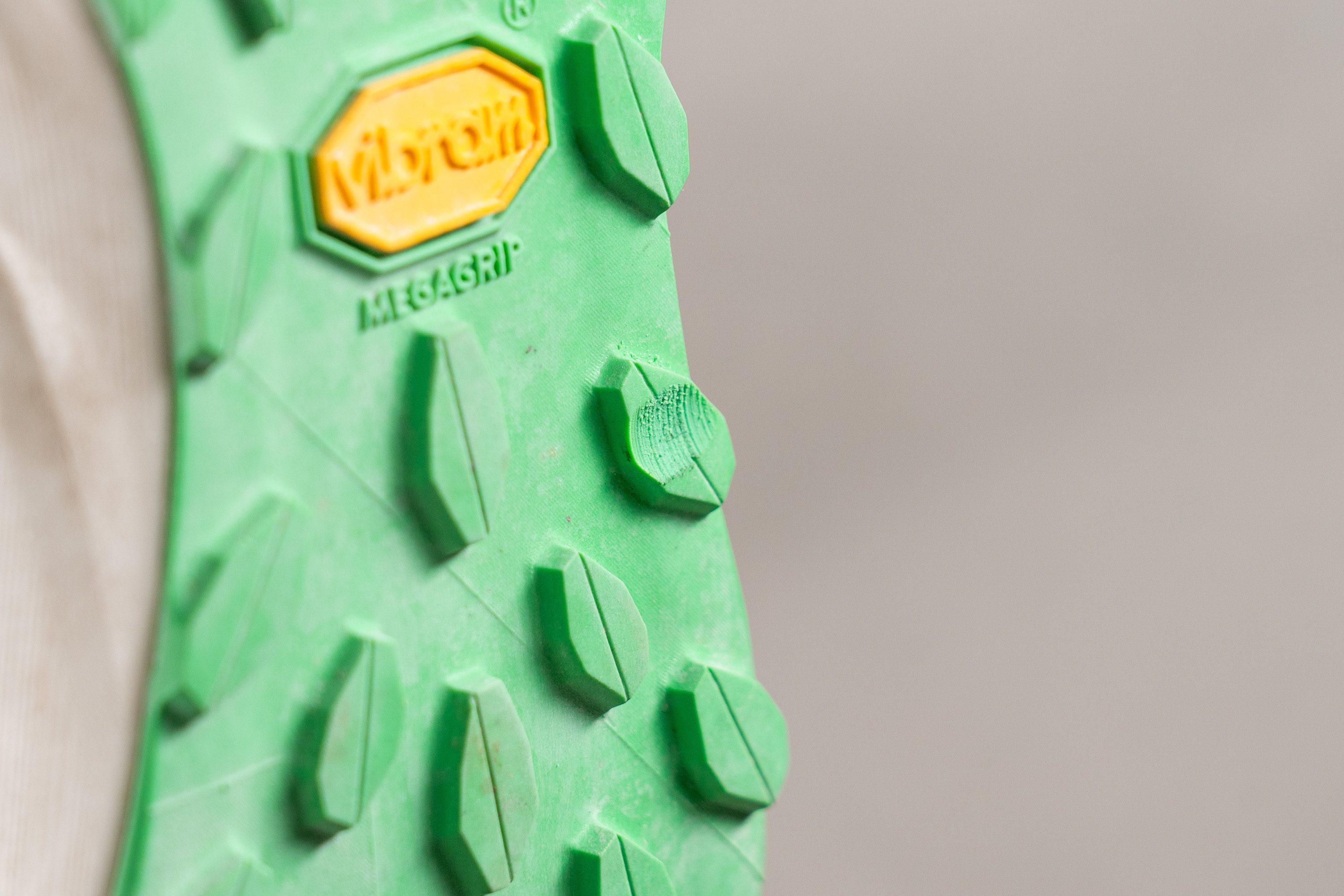
| Kjerag | 1.0 mm |
| Average | 0.9 mm |
Outsole thickness
The difference between standard Vibram Megagrip and Litebase lies in weight—Litebase is 30% lighter, achieved with a 50% thinner design. For a competition shoe like this, we think the trade-off is worth it.
Sure, protection from sharp rocks is reduced—especially since there’s no rock plate—but the shoe feels closer to the ground and more responsive, with a noticeable reduction in heft.

| Kjerag | 1.0 mm |
| Average | 2.2 mm |
Misc
Removable insole
We couldn’t remove the insole of the Kjerag, making it one of the rare trail shoes on the market with a fixed insole. While this means you can’t swap it out, it offers advantages like a more precise fit and reduced foot slippage.
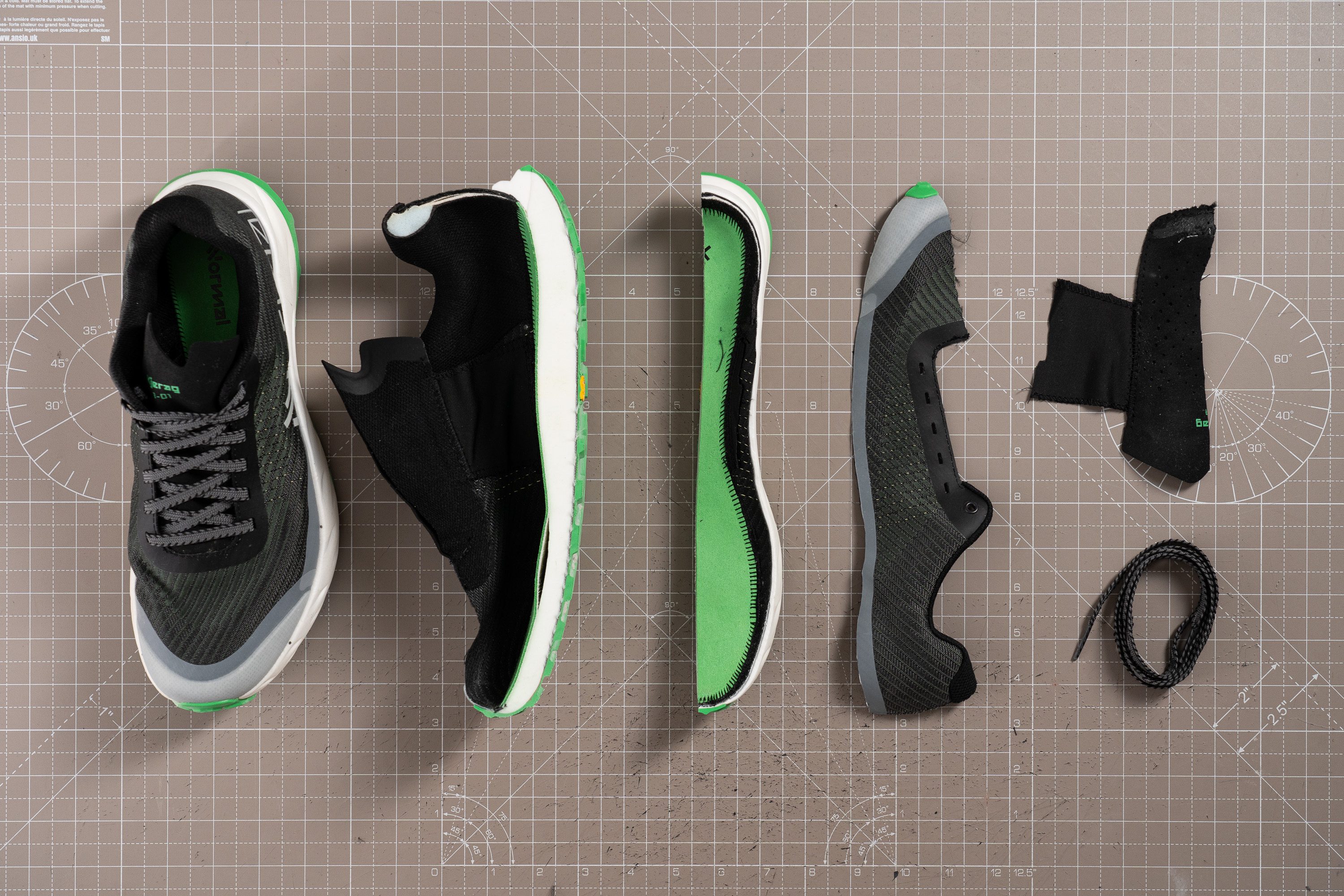
| Kjerag | No |
Midsole softness in cold (%)
Since the Kjerag features an EVA-based foam, we weren’t surprised by its performance in our 20-minute freezer test—more on the underwhelming side, honestly. The EExpure foam became 33.9% firmer, noticeably so, but nothing dramatic.
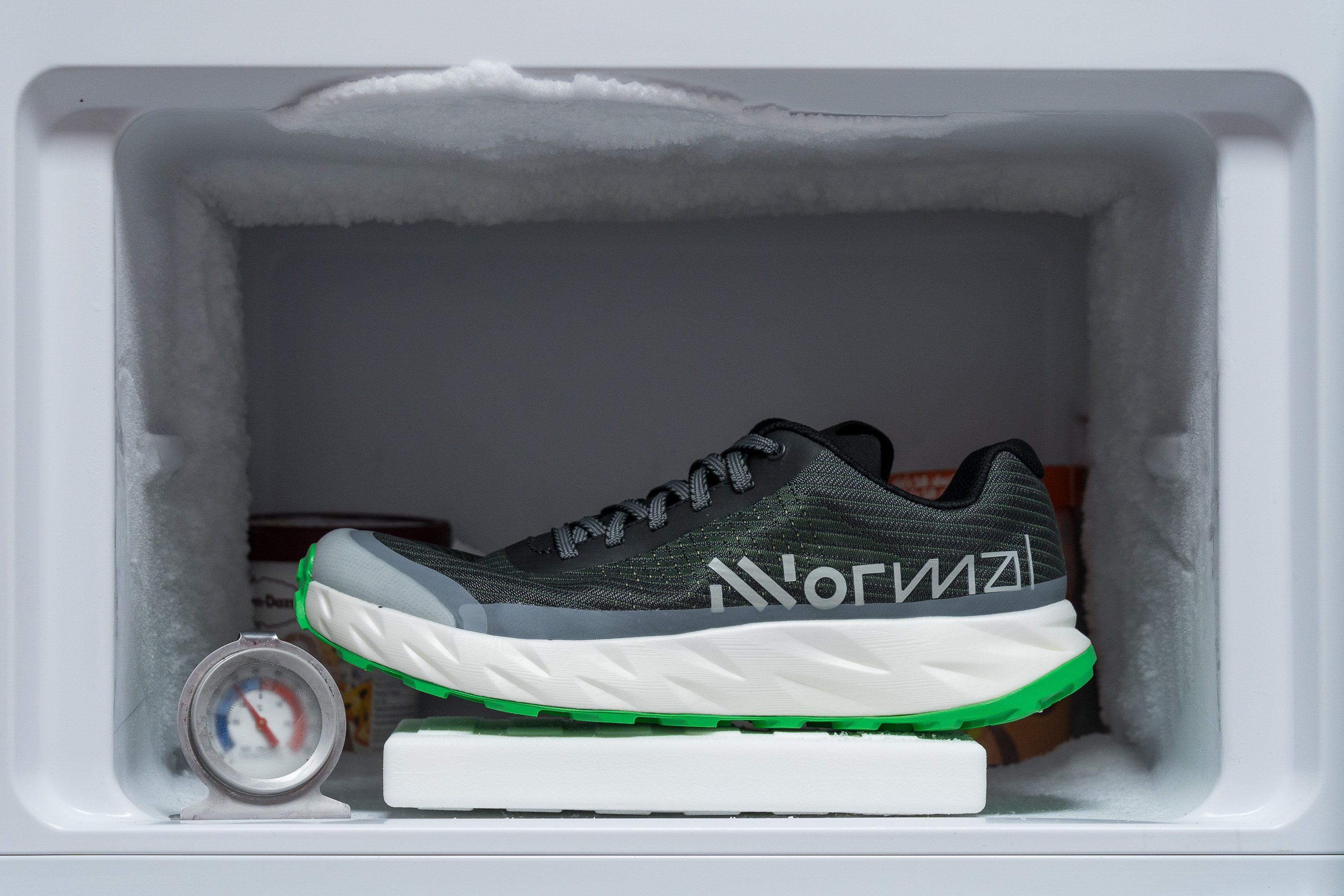
| Kjerag | 34% |
| Average | 26% |
Reflective elements
For a trail shoe in the premium price range, we found it a bit disappointing that it lacks reflective elements—especially since we've seen this model multiple times in races that kick off in the dark.

| Kjerag | No |
Tongue padding
The Kjerag uses a classic lacing system with punched eyelets. While the laces are high-quality and stay securely in place, we found ourselves wishing for an extra eyelet to accommodate alternative lacing styles.
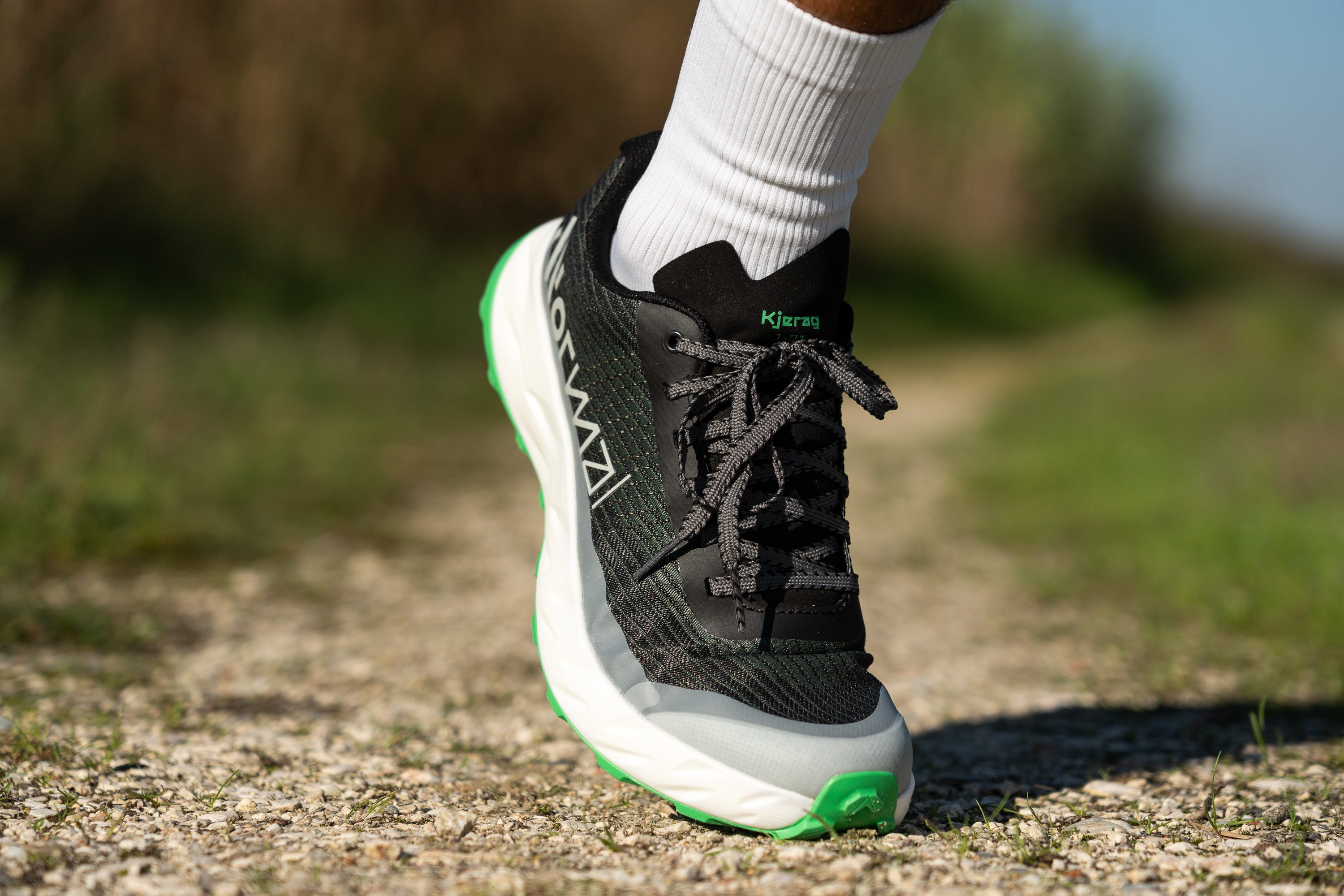
The tongue is as slim as expected from a minimalist race-day shoe and features an assymetric design that looks really similar to the one we found in the Nike Vaporfly 3. With just 1.5 mm of padding, it closely resembles the streamlined feel of road supershoes like the ASICS Metaspeed Sky Paris!
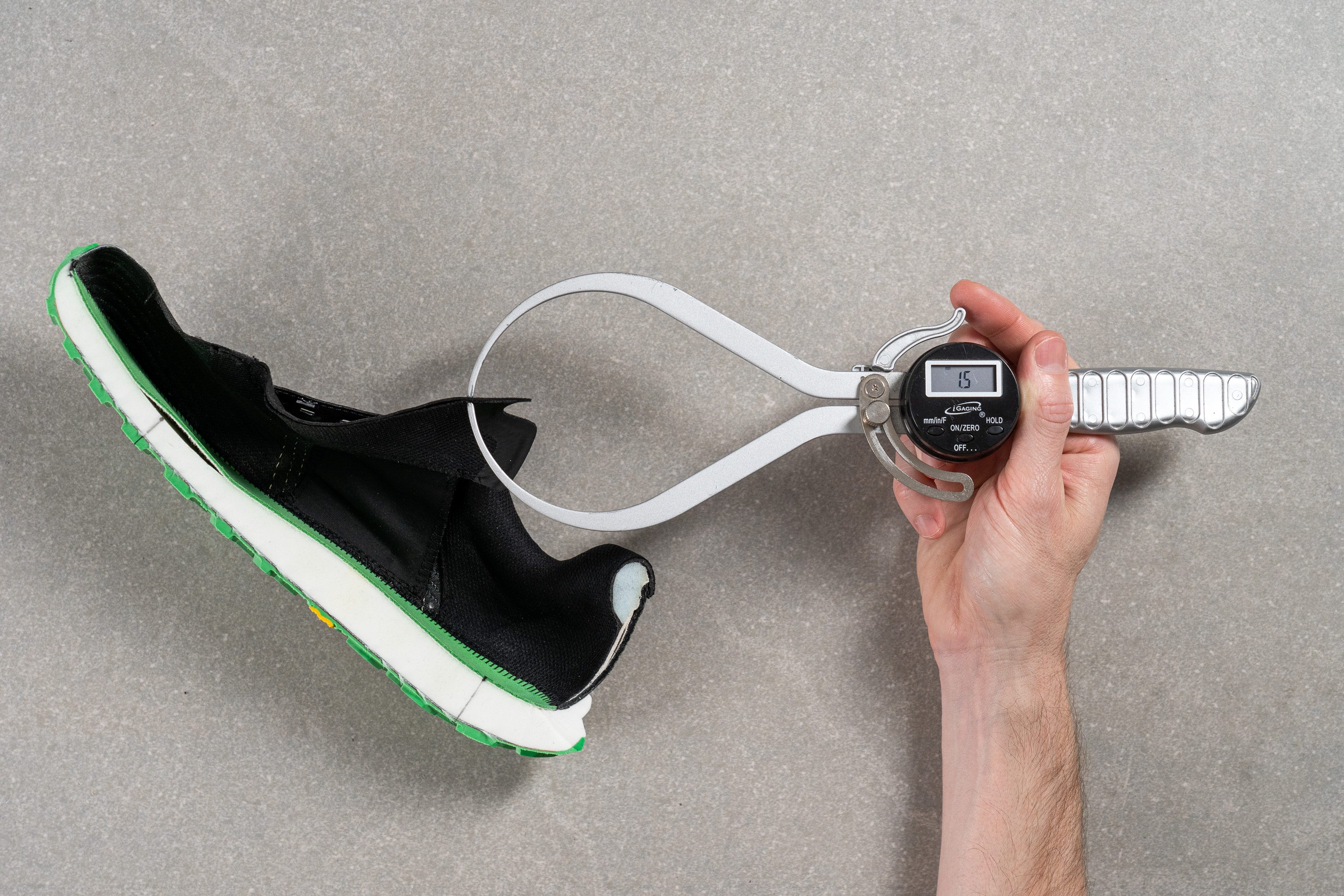
| Kjerag | 1.5 mm |
| Average | 6.4 mm |
Tongue: gusset type
Most trail shoes go for fully gusseted tongues, but the NNormal Kjerag uses a semi-gusseted design—and we’re all for it. It dramatically enhances lockdown, a crucial feature given the shoe’s ultra-thin tongue. Speaking of which...

| Kjerag | Both sides (semi) |
Price
This isn’t an affordable trail shoe—it’s quite the opposite! However, NNormal isn’t aiming to sell millions or attract budget-focused buyers. Instead, they’re carving out a place in the high-end market, targeting runners who prioritize high-quality footwear with a lower carbon footprint.

In our view, part of the cost also reflects that NNormal is a newer brand. As we’ve seen with Hoka or On, prices often adjust as brands grow, gain market share, and can manufacture larger quantities.
| Kjerag | $195 |
| Average | $153 |
Heel tab
NNormal seems comfortable stepping away from common design practices, skipping the finger-loop heel tab—a staple on most trail running shoes. We believe they aimed to minimize every unnecessary gram like we found with the tongue, prioritizing a lightweight, streamlined design.
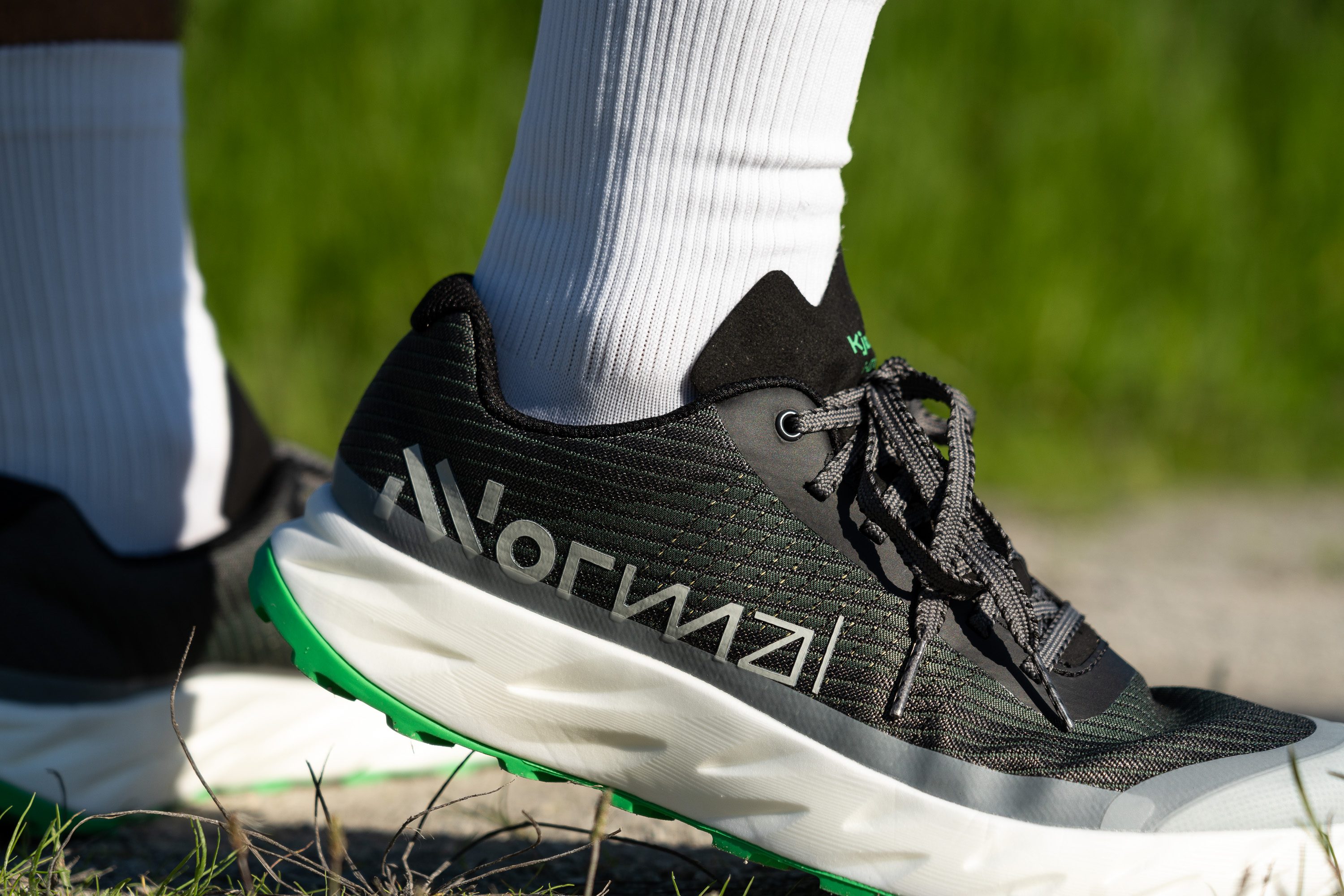
| Kjerag | None |
What's NNormal?
It’s rare to see new brands enter the trail running scene with the impact NNormal has achieved. That’s no coincidence—this brand stems from a collaboration between Kilian Jornet and the well-established Spanish brand Camper. It also marked Kilian’s departure from Salomon, with this shoe drawing significant inspiration from previous S/Lab models by the French brand.
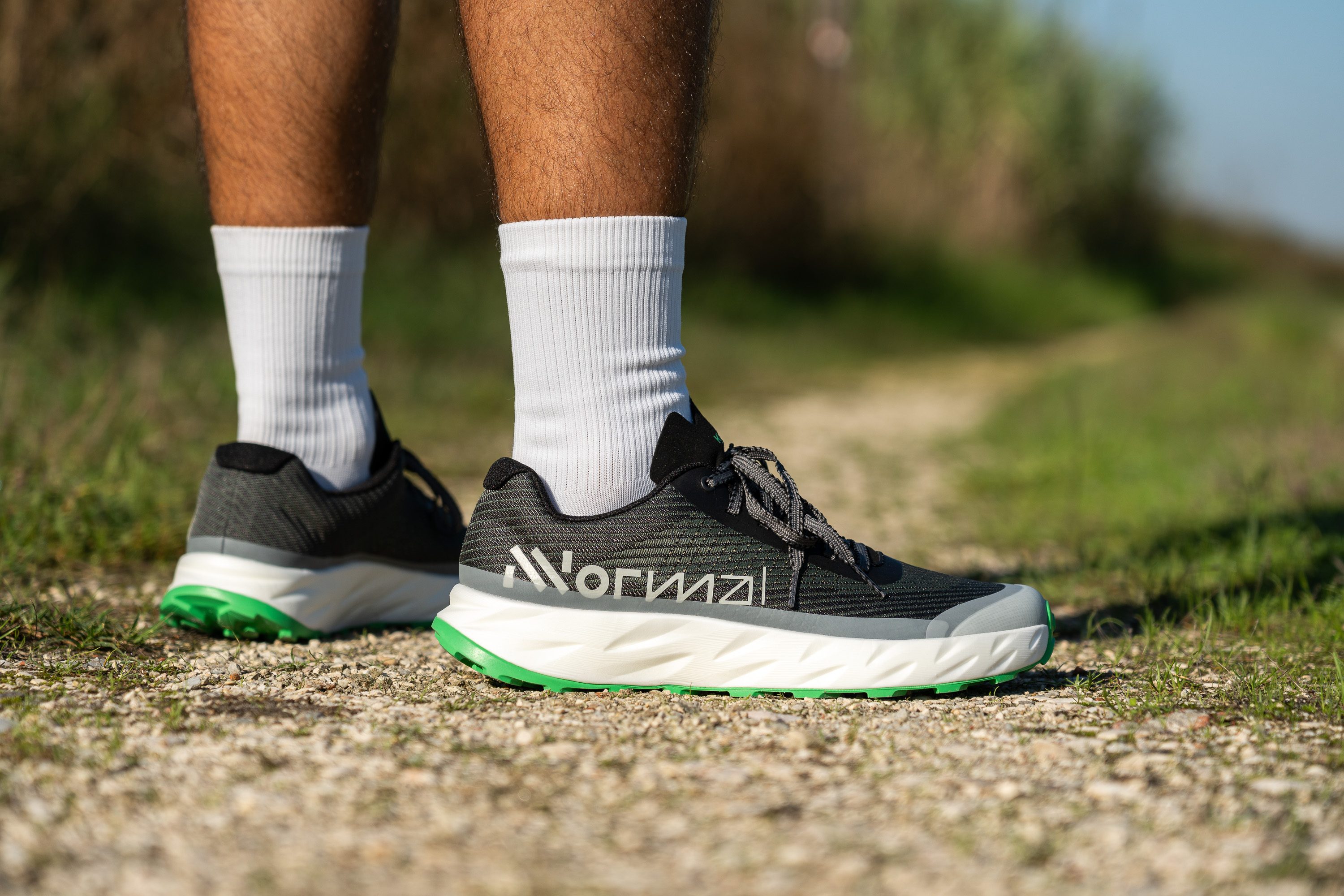
NNormal’s mission is clear: while profit is essential, they aim to redefine success through eco-friendly, high-quality, low-carbon-footprint shoes that can even be self-repaired. It’s a refreshing shift from the industry norm and we like it—in fact, we’re hopeful that more new players like this will emerge in the future.

